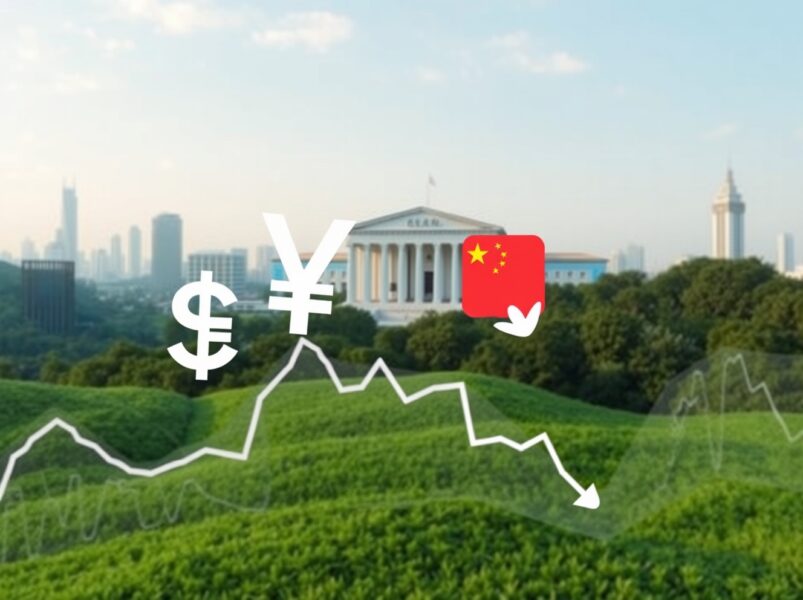Asia FX Tremors: Dollar Recovery Challenges Regional Currencies While Yen Gains Power
0
0

BitcoinWorld

Asia FX Tremors: Dollar Recovery Challenges Regional Currencies While Yen Gains Power
In the fast-paced world of global finance, where every ripple can send waves across markets, recent movements in the Forex Market are capturing significant attention. For those deeply entrenched in the cryptocurrency space, understanding these macro shifts is paramount. A stronger U.S. dollar, for instance, can often impact risk appetite, influencing capital flows and, by extension, the sentiment around digital assets. Currently, we are witnessing a crucial juncture where the dollar’s resurgence is creating a distinct dynamic, particularly within Asian currency markets, while the Japanese Yen carves out its own path. Let’s delve into the intricacies of these developments and what they signify for the broader financial landscape.
Understanding the Dollar Recovery: What’s Driving the Greenback’s Resurgence?
The U.S. dollar, often seen as the global reserve currency and a safe haven, has been staging a notable recovery. This resurgence isn’t accidental; it’s a confluence of several powerful economic forces. Primarily, robust economic data emerging from the United States has played a pivotal role. Strong employment figures, resilient consumer spending, and an inflation rate that, while moderating, remains a concern for policymakers, have all contributed to a narrative of U.S. economic exceptionalism.
- Interest Rate Differentials: The Federal Reserve’s commitment to maintaining a restrictive monetary policy stance, even as other central banks consider easing, creates attractive yield differentials. Higher interest rates in the U.S. make dollar-denominated assets more appealing to global investors, increasing demand for the greenback.
- Safe-Haven Demand: Global geopolitical uncertainties and economic slowdowns in other major economies often lead investors to seek refuge in the perceived safety of the U.S. dollar. This flight to quality strengthens the dollar, especially during periods of market volatility.
- Economic Resilience: Compared to many other developed nations, the U.S. economy has shown remarkable resilience, defying recession fears. This positive outlook attracts foreign direct investment and portfolio inflows, further bolstering the dollar.
This strengthening dollar has profound implications, not just for traditional assets but also for the cryptocurrency ecosystem, where a stronger dollar can sometimes signal a ‘risk-off’ environment, potentially leading to outflows from riskier assets like Bitcoin and altcoins.
Navigating Muted Asia FX: How Are Regional Currencies Faring?
Against the backdrop of a recovering dollar, currencies across Asia have largely remained muted, experiencing varying degrees of pressure. The strength of the U.S. dollar makes imports more expensive for Asian nations and can lead to capital outflows as investors seek higher returns in dollar-denominated assets. This dynamic puts central banks in a challenging position, balancing the need to support economic growth with the imperative to maintain currency stability.
Consider the performance of key Asian currencies:
Currency Performance Snapshot (Illustrative)
| Currency | Recent Trend Against USD | Key Influencing Factors |
|---|---|---|
| Korean Won (KRW) | Slightly weaker | Export performance, semiconductor cycle, domestic inflation. |
| Malaysian Ringgit (MYR) | Modestly weaker | Commodity prices (oil, palm oil), U.S. rate expectations. |
| Indonesian Rupiah (IDR) | Relatively stable, some pressure | Commodity exports, robust domestic demand, foreign portfolio inflows. |
| Chinese Yuan (CNY) | Carefully managed, some depreciation pressure | Economic growth concerns, PBoC policy, trade balance. |
The muted response in Asia FX reflects a delicate balancing act. While some economies benefit from strong export demand, the overall sentiment is tempered by the prospect of higher U.S. interest rates and the potential for reduced global trade volumes. Central banks in the region are closely monitoring these developments, often intervening in markets to prevent excessive volatility, which could destabilize their economies. The challenge lies in managing inflation without stifling economic growth, all while contending with external pressures from the dollar’s strength.
The Surge of Yen Strength: What’s Behind Japan’s Currency Revival?
While much of Asia FX faces headwinds, the Japanese Yen (JPY) has shown a distinct firmness, standing out from its regional counterparts. For years, the Yen was a poster child for weakness, battered by the Bank of Japan’s (BOJ) ultra-loose monetary policy and significant interest rate differentials. However, recent developments suggest a potential turning point, leading to notable Yen Strength.
- Shifting BOJ Stance: The primary driver behind the Yen’s recent appreciation is the growing market expectation of a hawkish pivot from the Bank of Japan. For a long time, the BOJ maintained negative interest rates and a strict yield curve control (YCC) policy, capping long-term bond yields. However, persistent inflation, even if modest by global standards, is putting pressure on the BOJ to normalize policy.
- Speculation on Policy Adjustments: Traders are increasingly betting that the BOJ will either scrap its negative interest rate policy, adjust its YCC framework, or both, in the near future. Any move away from its long-standing dovish stance would narrow the interest rate differential with other major economies, making the Yen more attractive.
- BOJ ETF Sales Ring Hawkish: A particularly significant signal came from reports of the BOJ reducing its holdings of exchange-traded funds (ETFs). While not a direct monetary policy tool in the same vein as interest rates, the BOJ’s historical purchases of ETFs were part of its unconventional easing measures aimed at supporting asset prices and the economy. A reduction in these holdings is interpreted by some market participants as a subtle, yet significant, step towards unwinding its massive stimulus program. This action, coupled with other subtle shifts in communication, is being read as a distinctly hawkish signal, fueling expectations of further policy normalization and contributing to Yen Strength.
This shift is not just about the Yen; it represents a significant potential change in one of the world’s most influential central banks, with ripple effects across global financial markets.
Decoding BOJ Policy: A Hawkish Turn or Strategic Maneuver?
The Bank of Japan (BOJ) has long been an outlier among major central banks, steadfastly maintaining an ultra-loose monetary policy even as its peers aggressively hiked rates. However, the narrative around BOJ Policy is rapidly evolving. The recent firmness in the Yen, particularly following reports of ETF sales, suggests that markets are interpreting the BOJ’s actions and communications as increasingly hawkish.
Is this a definitive hawkish turn, or a carefully calibrated strategic maneuver?
Key Aspects of BOJ’s Evolving Stance:
- Inflationary Pressures: Japan has experienced sustained inflation above the BOJ’s 2% target, driven by higher import costs and a weakening Yen. While the BOJ has long argued that this inflation is cost-push and not demand-driven, the persistence of price increases is becoming harder to ignore.
- Wage Growth: Crucially, there are signs of stronger wage growth in Japan, a key prerequisite for the BOJ to consider sustainable inflation and policy normalization. Significant wage hikes agreed upon in recent labor negotiations have fueled optimism.
- Yield Curve Control (YCC) Adjustments: The BOJ has already made subtle adjustments to its YCC policy, widening the band within which 10-year Japanese government bond (JGB) yields are allowed to fluctuate. This was seen as a precursor to further normalization.
- ETF Sales as a Signal: The reported reduction in BOJ ETF holdings is particularly telling. While the BOJ may frame it as a technical adjustment, the market sees it as a withdrawal of stimulus, aligning with a more hawkish posture. It signals a readiness to reduce its massive balance sheet, a step towards normalization that many have awaited.
The challenge for the BOJ is to manage expectations without causing undue market disruption. A sudden, aggressive shift could lead to excessive Yen appreciation, harming Japan’s export-oriented economy, and potentially destabilizing global bond markets. Therefore, any move is likely to be gradual and well-communicated, but the direction of travel appears increasingly clear: away from ultra-dovishness towards a more normalized BOJ Policy.
Impact on the Global Forex Market: What Lies Ahead for Traders?
The interplay of a recovering U.S. dollar, muted Asia FX, and a firming Yen creates a complex and dynamic environment for the global Forex Market. These shifts have far-reaching implications for international trade, capital flows, and investment strategies. Traders and investors need to be acutely aware of these trends to navigate the coming months successfully.
Challenges and Opportunities:
- For Exporters and Importers: A strong dollar makes U.S. exports more expensive and imports cheaper. For Asian nations, a strong dollar and a relatively weaker local currency make imports pricier, potentially fueling domestic inflation. Conversely, a stronger Yen could make Japanese exports less competitive but reduce the cost of imports for Japanese consumers and businesses.
- For Global Investors: The divergence in monetary policies (Fed tightening, BOJ potentially normalizing, other central banks contemplating easing) creates opportunities in currency pairs. Carry trades, where investors borrow in a low-interest-rate currency to invest in a high-interest-rate currency, could see renewed interest, particularly with a hawkish BOJ.
- Capital Flows: A strong dollar tends to attract capital to the U.S., potentially drawing funds away from emerging markets in Asia. However, a more stable or appreciating Yen could attract foreign investment into Japan, particularly if accompanied by positive economic reforms.
- Volatility: Periods of significant policy shifts or economic divergence often lead to increased currency volatility. This presents both risks and opportunities for short-term traders.
Actionable Insights for the Forex Market:
- Monitor Central Bank Communications: Pay close attention to statements from the Federal Reserve, Bank of Japan, and other Asian central banks. Their forward guidance is crucial.
- Track Economic Data: Key economic indicators (inflation, GDP, employment) from the U.S. and Japan will continue to drive currency movements.
- Diversify Portfolios: Given the evolving landscape, diversification across different currencies and asset classes can help mitigate risks.
- Consider Hedging Strategies: Businesses engaged in international trade should review their hedging strategies to protect against adverse currency movements.
The coming months promise to be dynamic in the Forex Market as these powerful forces continue to unfold, shaping the global financial architecture.
Conclusion: A Shifting Global Currency Landscape
The current state of the global Forex Market is a testament to the intricate dance of monetary policy, economic fundamentals, and geopolitical factors. The U.S. dollar’s robust recovery, fueled by economic resilience and hawkish Federal Reserve expectations, is exerting pressure on many Asia FX currencies, leading to a largely muted performance across the region. However, the Japanese Yen stands as a notable exception, experiencing significant Yen Strength. This appreciation is largely driven by growing market conviction that the BOJ Policy is on the cusp of a significant hawkish shift, with recent ETF sales ringing as a particularly strong signal. For investors and traders, understanding these divergent trends is crucial. The implications range from altered trade dynamics and capital flows to new opportunities in currency pairs. As central banks continue to navigate inflation and growth challenges, the global currency landscape remains a fascinating and vital area of focus, directly influencing broader financial stability and investment decisions.
To learn more about the latest Forex market trends, explore our article on key developments shaping the US Dollar, Yen, and other global currencies, and their impact on liquidity and institutional adoption.
This post Asia FX Tremors: Dollar Recovery Challenges Regional Currencies While Yen Gains Power first appeared on BitcoinWorld.
0
0
 Manage all your crypto, NFT and DeFi from one place
Manage all your crypto, NFT and DeFi from one placeSecurely connect the portfolio you’re using to start.






